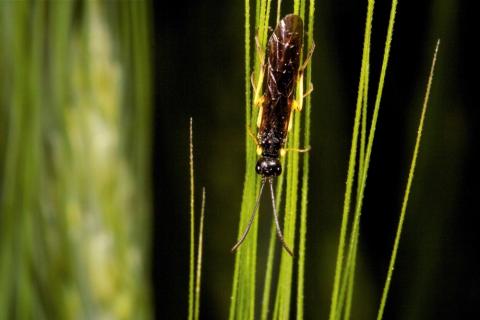Impact and Seed Production of Palmer Amaranth in Dry Beans
January 4, 2022
Results of a 2020-21 study investigating the impact of uncontrolled Palmer amaranth in dry beans. Using pinto beans, researchers were able to pinpoint yield loss and potential seed production of Palmer amaranth.
Degree-days for Prediction of Western Bean Cutworm Flight
June 21, 2022
Measuring the amount of heat between an upper and lower threshold to which an insect has been exposed, degree-days models can provide a high level of precision in predicting western bean cutworm peak flight.
Wheat Stem Sawfly Emergence — Field Notes from Early June
June 7, 2021
Recent observations indicate very high populations of wheat stem sawfly in Nebraska wheat fields, with emergence not only from field edges but also deep within fallow fields. Documentation on infestations is encouraged for successful fall sawfly management.
Alfalfa Weevil Surging in Alfalfa Fields
May 8, 2024
Alfalfa weevil larvae have emerged in southeast, south-central and central Nebraska; scouting for this pest is crucial for alfalfa producers over the next few weeks.
Army Cutworm Scouting Urged in Western Nebraska Wheat and Alfalfa
March 31, 2021
With Army cutworms sightings reported from in Kansas, Extension experts encourage scouting efforts begin in Nebraska's fields — particularly in the west.
How Have the Cold February Temperatures Affected Insect Overwintering in Nebraska?
February 26, 2021
Extension specialists detail what effect February's bitter temperatures and snow cover may have on overwintering insects in Nebraska.
Wheat Stem Sawfly in 2020
September 1, 2020
This article provides a brief background on how the wheat stem sawfly arrived here, ideas on how we might manage it in Nebraska and thoughts on why we saw reduced damage in some regions while others had the most damage they have ever seen.
Wheat Stem Sawfly Infestations Continue to Impact Harvest in the Nebraska Panhandle
July 23, 2020
WSS damage in winter wheat was first noted in Nebraska in the early to mid-1990s in Banner County near the Wyoming border. It has continued to increase ever since and now is a very significant issue.









